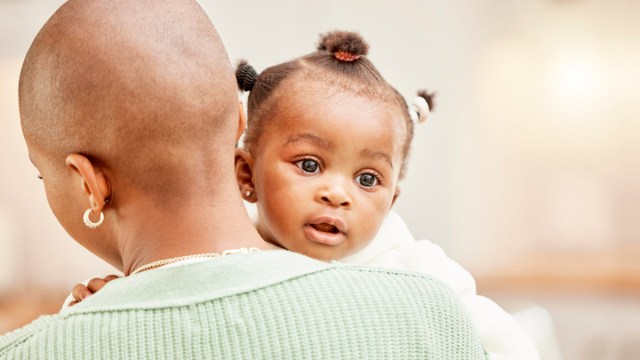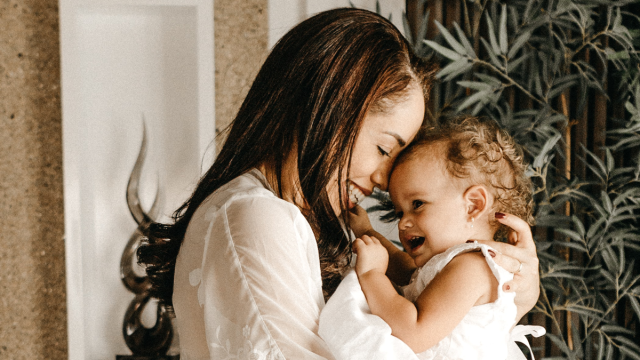From cultural norms and parent preference to the question of consent, there are a lot of factors that go into deciding the right time to pierce a child’s ears. We asked pediatricians and other experts for their perspectives on the ideal age (and potential pros and cons of infant ear piercing), as well as the best places to take kids to get their ears pierced, and what parents should know and consider ahead of time.
What Experts Say About Infant Ear Piercing

The American Academy of Pediatrics recommends postponing piercing “until your child is mature enough to care for the site herself.” However, they also say that if a piercing is performed carefully and cared for conscientiously, there is little risk, no matter the child’s age.
Nivedita More, MD, a pediatrician at Bayside Medical Group at Stanford Medicine Children’s Health, echoes this advice. While she recommends waiting until kids are older, she says that “if the parents desire to get their child’s ears pierced when they are younger, I recommend they get it 1-2 weeks after the second set of their primary vaccines, after four months of age, so they are protected against tetanus.”
As a general rule, hospitals in North America aren’t equipped to pierce the ears of newborns. “It is best for parents to check with their pediatrician regarding when and where this procedure can be performed safely by a pediatrician or a nurse or a trained technician under sterile precautions if desired,” More says.
You can also visit the Association of Professional Piercers’ (APP) website to find a reputable piercer in your area.
Should You Wait for Consent?

When it comes to the question of ear piercing for kids, some parents want to hold off modifying their child’s body until they’re old enough to decide for themselves. And if you feel this way, then waiting is the right choice. That being said, many parents do make non-medical choices without their child’s consent. Haircuts come to mind. Hair grows back. And skin does, too, if a child later refuses to wear earrings. No peer-reviewed studies link baby ear piercing with long-term mental or emotional trauma. But there are physical pitfalls to avoid when piercing your kiddo’s ears.
Always check with your pediatrician if your little has a chronic health condition. And remember that those tiny lobes will need weeks of aftercare. If you can’t commit to an additional cleaning routine, consider waiting until your kid can handle the chore themselves.
Be aware that the younger the child, the harder it might be to find someone to pierce their ears. “ Many piercers prefer to wait until the child is old enough to request the piercing,” says Jef Saunders, past President of the Association of Professional Piercers and co-owner of Gamma Piercing. “I have several piercers who work for me, and none of them feel comfortable working with babies at this time. It is a personal decision for everyone involved, parent and piercer, so it may take some time to find the right fit.”
What to Look for When Taking Kids to Get Their Ears Pierced

As a general rule, find a business that makes the majority of its money piercing instead of selling jewelry. The expertise of the workers will reflect that focus.
Run, do not walk, away from any place that says “extensive experience” and refuses to give you a specific number. “Most quality shops will be happy to explain their training and continuing education, as well as their health and safety practices,” says Saunders. “If the store has a website, look for a commitment to jewelry quality, service, and safety over cheap price claims.” Do they use needles or an ear-piercing gun to pierce ears? The APP does not recommend using ear-piercing guns as “most…can’t be sterilized, and anyone being pierced by them is at risk. A reputable professional won’t use a gun for piercing–even for ear lobes.”
Saunders recommends looking “for a clean, well-lit facility. Attitude tells you a lot about a piercing shop. Look for folks interested in helping you, and seem enthusiastic about performing the piercing you are requesting. Trust your instincts! If you get a bad feeling about a situation or a facility, it is best to go home and sleep on it rather than push forward.”
The studio should also offer jewelry that is appropriate for new piercings. Ask for Titanium, Niobium, or 14k Gold that is nickel- and cadmium-free and alloyed for biocompatibility. Gold-plated or gold-overlay earrings aren’t acceptable. The metal below the coating can leach into baby’s skin, potentially causing contact allergies.
Platinum is also safe for little ears but is expensive. The first set of earrings will have longer-than-average posts to accommodate the initial swelling from the procedure. If you want to gift your child with heirloom-quality jewelry, consider saving your dollars for the second set of earrings. They're more likely to wear them after their ears heal up.
What to Know Before Getting Kids' Ears Pierced
“You can spare yourself an extra visit to the piercing studio by reading their ID and age requirements thoroughly before visiting,” advises Saunders. “Many states will require professional piercers to have photo ID for the parent, as well as birth certificates for the child being pierced. Some states even require a notarized copy of the paperwork! Reviewing paperwork requests, aftercare, and giving a little extra time to choose jewelry can really help the piercing experience go smoothly!”
Getting your baby’s ears pierced is a family decision. Take time to discuss the right timing for your cultural context. And do your homework before you go. You’ll set your child up for a smooth, safe experience at any age.
The Cultural Context Behind Infant Ear Piercing
For many families, piercing baby ears at one month or as a pre-teen boils down to culture. If your mother pierced your ears as a baby, and her mother pierced her ears as a baby, then piercing your baby’s ears is more than vanity—it links them to family history. It’s a rite of passage for both the child and the parent. For Hindus in India, it’s also an important part of religious tradition. The Karna Vedha Zanskar requires piercing a baby’s ears (of both genders) in either the first or third year of life.
Even for the non-religious, piercing your small fry’s ears early is viewed as a service. According to statista.com, over 80% of women have pierced ears. If you assume that your child will follow the trend, then getting an infant's ears pierced at three months, for example, means they won’t remember the pain of the procedure.
The best course of action is to decide on the right timing as a family. Your child’s other parent might have a strong opinion different from yours. Or you may discover that you aren’t as attached to this particular tradition as you thought. “In Chile, many baby girls are pierced after a couple of days of being born,” says Claudia Diaz, mother of one. “At that moment [of my daughter’s birth], I didn't put so much thought into it, and I followed the tradition. When I came to Canada, I felt I should not have done it because it was unnecessary. Now [that my daughter is a teen], I don't regret it because she has several piercings in her ears and one in her nose.”
Tired new parent?
Subscribe to our weekly newsletter packed with expert tips and simple solutions that make life with baby less exhausting—and more fun.
By subscribing you agree to Tinybeans Terms and Privacy Policy











